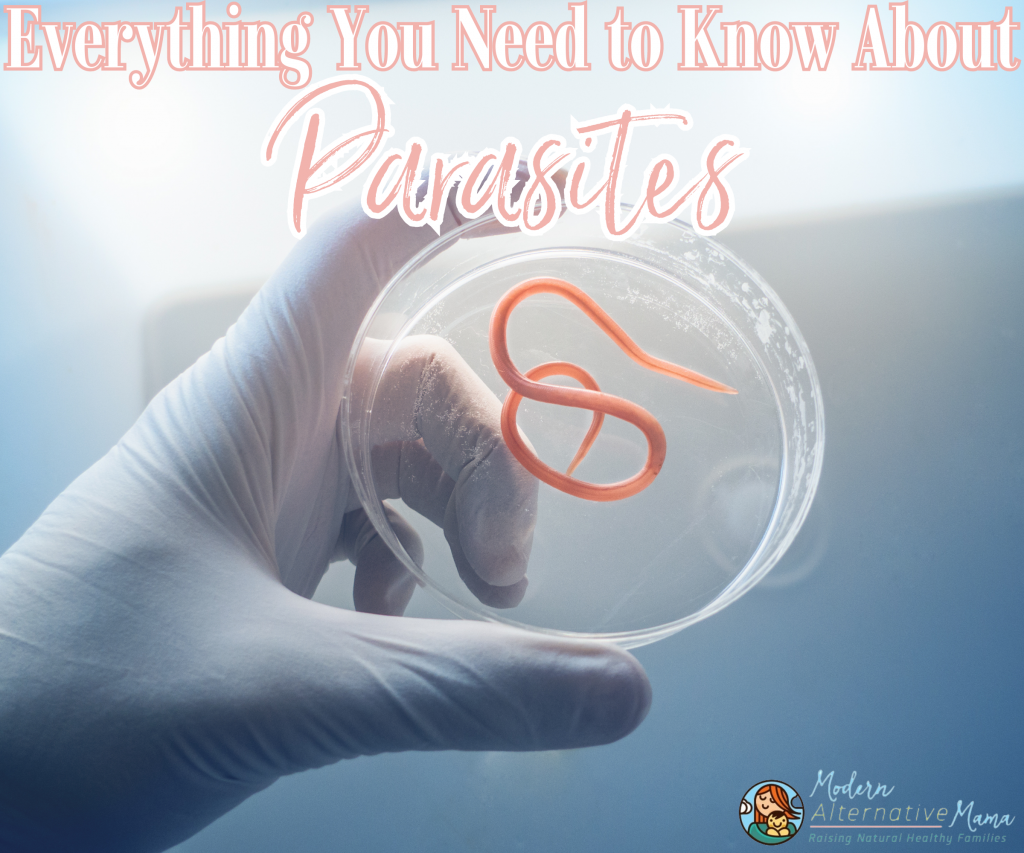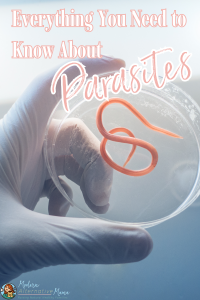Parasites. Parasite cleanses. Kill the parasites. As a member of the natural health community, I’ve heard it all. And as someone diagnosed with a parasitic infection as a teenager, I will say it’s not fun.
Here’s the thing, everyone has some type of parasitic load, and aiming to kill them all isn’t necessarily the answer. The key is to manage and create a healthy balance as we do with the good and bad bacteria in our gut microbiome. You may have read that and thought I was insane, but keep reading because not all parasites are harmful.
Types of Parasites
Parasites are not a disease, but they can spread diseases, some of which are fatal. Different parasites affect the human body differently, but not all parasites are bad.
Most parasites reside inside their hosts and eat the internal tissues (gonads and digestive glands), but some are nonpathogenic. Nonpathogenic parasites use their hosts as shelters and feed outside the hosts, such as the food the host eats, making them harmless, even in people with weak immune systems (1). Let’s discuss the three main types of parasites that affect humans– protozoa, helminths, and ectoparasites.
Protozoa
Protozoa are one-celled animals found in most habitats worldwide. With over 50,000 species, these parasites are free-living (uninhibited), and all higher animals are infected with at least one species of protozoa (2). These parasites are transmitted through a fecal-oral route, which can occur via contaminated food and water, person-to-person contact, and insect bites (3).
Research indicates virtually all humans have protozoa living in or on their bodies at some time, and many are infected with one or more species throughout their life. Some species of protozoa are considered harmless, while others produce disease (2).
Diseases caused by protozoa include malaria, trypanosomiasis, leishmaniasis, toxoplasmosis, and cryptosporidiosis (4). The spectrum of intestinal protozoal infections can range from asymptomatic to invasive disease (in the cases of E histolytica or B coli).
Signs of a protozoa infection include (5):
- Acute fulminant or necrotizing colitis: Sudden constipation following an acute and severe episode of dysenteric diarrhea that is followed by signs of shock.
- Ameboma: Although rare, the granulation tissue in the cecum or ascending colon presents as a tender, palpable lower-left quadrant abdominal mass.
- Intestinal amebiasis or amebic colitis: Chronic non-dysenteric diarrhea combined with months or years of abdominal pain, flatulence, stool mucus, and weight loss.
- Liver abscess: Fever lasting 1-2 weeks, abdominal pain, and poor appetite. Although less common, experiencing a cough, pleuritic chest pain, diarrhea, and jaundice is possible.
- Noninvasive intestinal infection: Alternating periods of mild diarrhea and constipation with or without mild abdominal pain.
Helminths
Helminths are parasitic worms with elongated, flat, or round bodies, with over 100,000 species (6). Helminths are typically classified based on the external and internal morphology of egg, larval, and adult stages (7). These parasites are transmitted in four ways – ingesting eggs, penetration by larvae, being bitten, or ingesting infected meat (8).
Research indicates helminths are problematic worldwide but more common and serious in poorer countries (8). These parasitic infections affect more than 1.5 billion people worldwide (9).
Diseases caused by helminths include enterobiasis, ascariasis, taeniasis, cysticercosis, and schistosomiasis (10). Heavy untreated parasitic infections can cause various health problems such as abdominal pain, diarrhea, blood and protein loss, rectal prolapse, and physical and cognitive growth retardation (11). Signs of a helminth infection include (12):
- Abdominal pain
- Diarrhea
- Blood loss, including blood in the stool
- Weakness or exhaustion
- Weight loss and malnutrition
- Restricted growth
- Cognitive effects (changes in thinking and memory)
- Rectal prolapse (the rectum protrudes beyond the anus)
Ectoparasites
Ectoparasites are small organisms that live outside the body, and usually infect only the skin’s surface layers (13). With over 800 species of ectoparasites, some common ones are mosquitos, ticks, fleas, bedbugs, and lice (14). These parasites are transmitted through grooming behaviors from infected humans and between animals (15).
Research indicates ectoparasite infections and diseases are very common, especially in impoverished communities (16). Common diseases caused by ectoparasitic infections include pediculosis, scabies, myiasis, tungiasis, and cutaneous larva migrans. Of course, another possibility is Lyme disease.
Signs of an ectoparasitic infection in humans vary depending on the type of parasite but are characterized as intense itching that causes annoyance and discomfort (15). Of course, in the case of Lyme disease, there’s the possibility of a bullseye rash. Check out our blog, How to Make a Tick Kit, to always be prepared.
Animals with an ectoparasitic infection may experience intense pruritus, scratching, biting, sleeplessness, nervousness, and a matted coat. Additionally, animals may encounter damage to the skin from scratching resulting in inflammation, excoriation, alopecia, and secondary bacterial involvement (17).
Understanding & Eliminating Parasites
Remember how I said not all parasites are harmful? Well, of course, by definition, parasites are harmful to their hosts, but some parasitic infections may have protective effects against certain diseases. Yes, you read that correctly.
Remember how I said helminths (parasitic worms) affect more than 1.5 billion people worldwide? Well, in studies, long-term worm infections decreased allergy and irritable bowel disease symptoms (18). Other studies have found when certain parasitic worms, like tapeworms and roundworms, set up camp in a body, they boost their host’s immune system (19). See, I told you all parasites weren’t harmful.
I know I originally said killing parasites isn’t the answer, but let’s face it some parasites are harmful, and we should want to eliminate them. You won’t be worried about killing them if you’re already doing things that prevent them. Again, it’s about managing and creating a healthy balance. So how can you prevent parasites?
First and foremost, studies have found interactions between intestinal microbiota, the immune system, and pathogens describing the human gut as a complex ecosystem (20). These components are relevant in modulating each other and maintaining a stable equilibrium.
For instance, one study discovered a relationship between several gut parasites and bacteria in different settings (21). Another study associated parasitic infections with unhygienic conditions, including food and water (22). As I said, it’s a lot like balancing the good and bad bacteria in our gut microbiome. Even mainstream sources recognize the connection between parasitic infections to the microbiome (23).
Some tips to minimize the risk of parasitic infections are:
- Thoroughly cook your meat
- Thoroughly clean your fruits and vegetables
- Avoid food toxins – check out Understanding Food Toxins
- Eat a clean, whole-foods diet – check out Cooking With Real Food
- Drink filtered water – check out Everything You Need to Know About Water Filters
- Wash your hands after using the bathroom or when dirty
- Scrape soap under your nails while gardening to avoid dirt buildup.
- Support your gut microbiome – check out The Gut Health Support Guide
- Support your immune system – check out The Immunity Tool Guide
- When outside, use bug repellant such as Earthley’s Pest Aside
- Incorporate antiparasitic foods in your diet – coconut oil, garlic, and pumpkin seeds
- Occasionally use a parasitic cleanse like Earthley’s Gut Health Oil
Of course, if you happen to have a parasitic infection that does require treatment, the go-to pharmaceutical would likely be ivermectin. Check out our blog, Everything You Need to Know About Ivermectin, which also discusses herbs with antiparasitic properties as alternatives.







